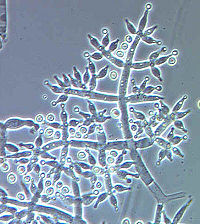
Photo from wikipedia
Plant survival in the terrestrial ecosystem is influenced by both beneficial and harmful microbes. Trichoderma spp. are a group of filamentous fungi that promote plant growth and resistance to harmful… Click to show full abstract
Plant survival in the terrestrial ecosystem is influenced by both beneficial and harmful microbes. Trichoderma spp. are a group of filamentous fungi that promote plant growth and resistance to harmful microbes. Previously, we showed that the genus Trichoderma could effectively suppress Fusarium wilt in cucumber. However, the mechanisms that underlie the effects of the genus Trichoderma on plant defense have not been fully substantiated. Two essential metabolic pathways, such as the ascorbate (AsA)-glutathione (GSH) cycle and the oxidative pentose phosphate pathway (OPPP), have been shown to participate in plant tolerance to biotic stressors; nevertheless, the involvement of these pathways in Trichoderma-induced enhanced defense remains elusive. Here, we show that Trichoderma harzianum could alleviate oxidative and nitrostative stress by minimizing reactive oxygen species (ROS; hydrogen peroxide and superoxide) and reactive nitrogen species (nitric oxide [NO]) accumulation, respectively, under Fusarium oxysporum infection in cucumber roots. The genus Trichoderma enhanced antioxidant potential to counterbalance the overproduced ROS and attenuated the transcript and activity of NO synthase and nitrate reductase. The genus Trichoderma also stimulated S-nitrosylated glutathione reductase activity and reduced S-nitrosothiol and S-nitrosylated glutathione content. Furthermore, the genus Trichoderma enhanced AsA and GSH concentrations and activated their biosynthetic enzymes, γ-GCS and l-galactono-1,4-lactone dehydrogenase. Interestingly, the genus Trichoderma alleviated Fusarium-inhibited activity of glucose-6-phosphate dehydrogenase and 6-phosphogluconate dehydrogenase, enzymes involved in the OPPP. Such positive regulation of the key enzymes indicates the adequate maintenance of the AsA-GSH pathway and the OPPP, which potentially contributed to improve redox balance, energy flow, and defense response. Our study advances the current knowledge of Trichoderma-induced enhanced defense against F. oxysporum in cucumber.
Journal Title: Phytopathology
Year Published: 2019
Link to full text (if available)
Share on Social Media: Sign Up to like & get
recommendations!